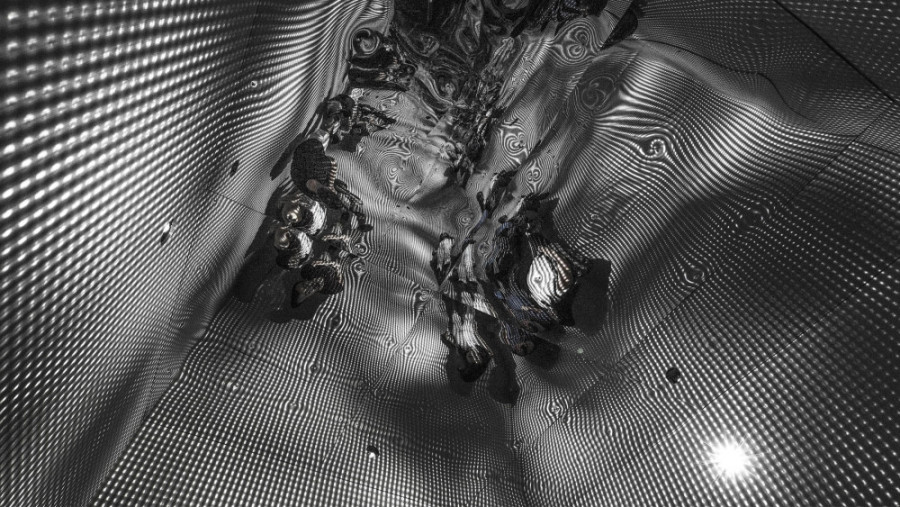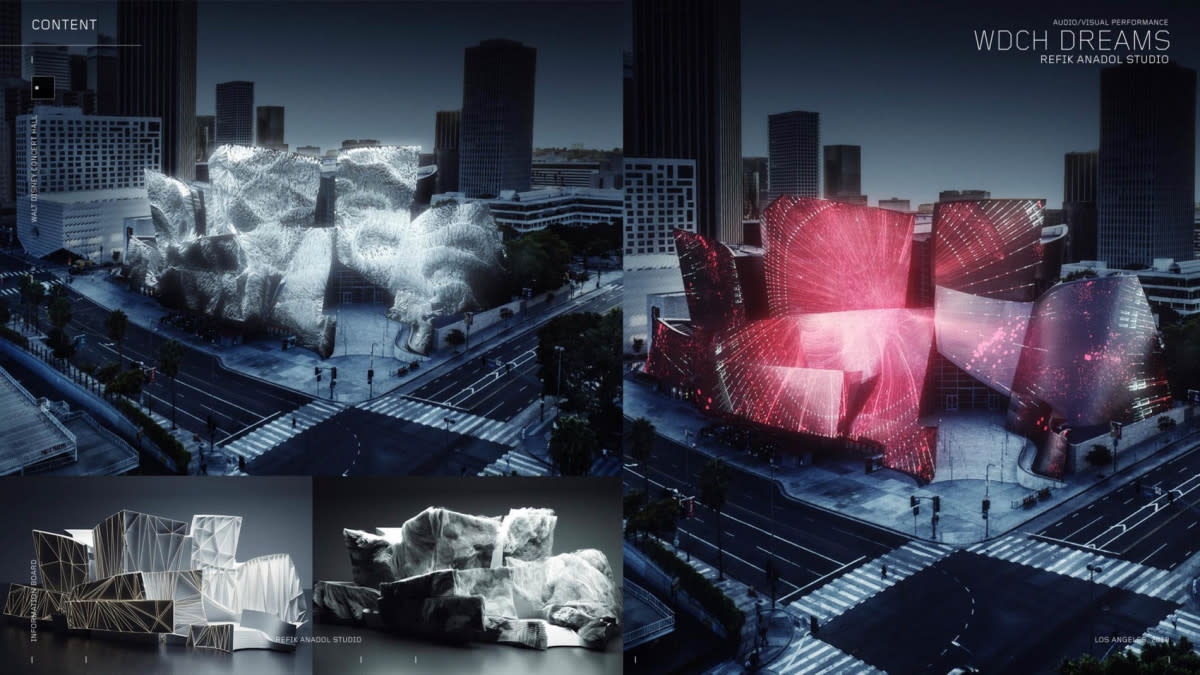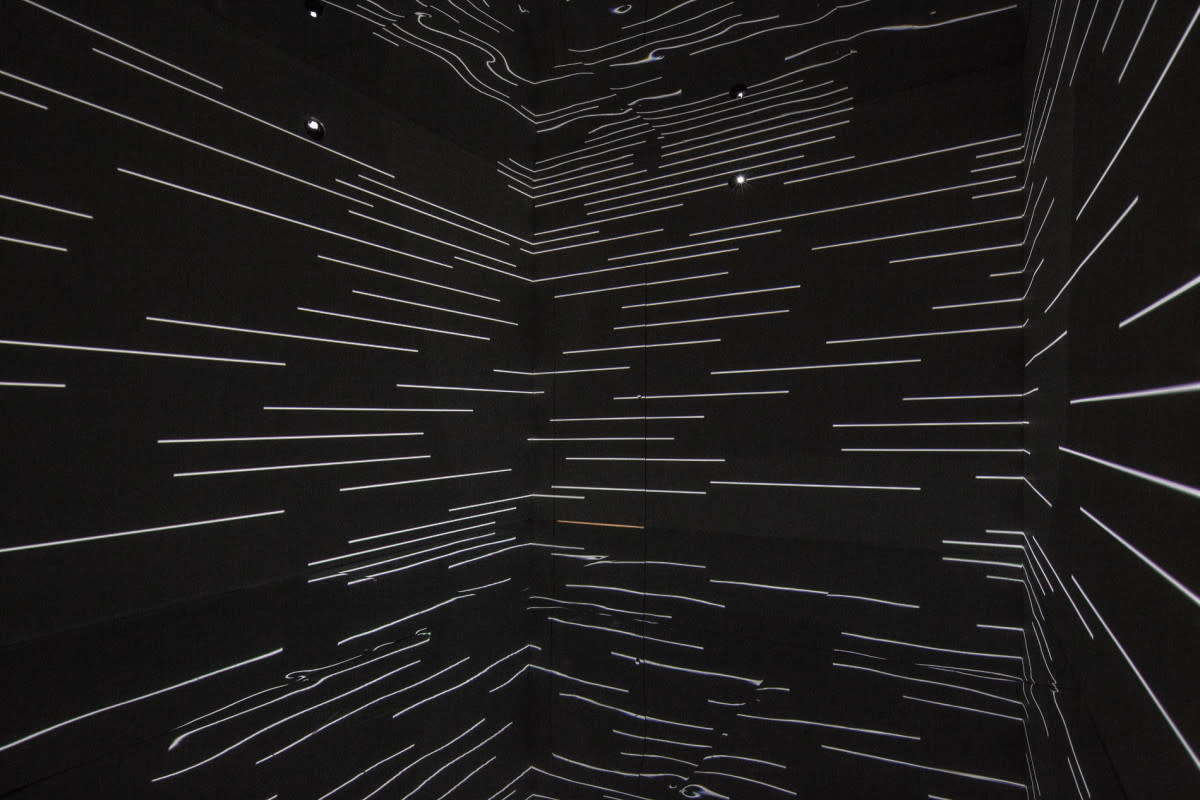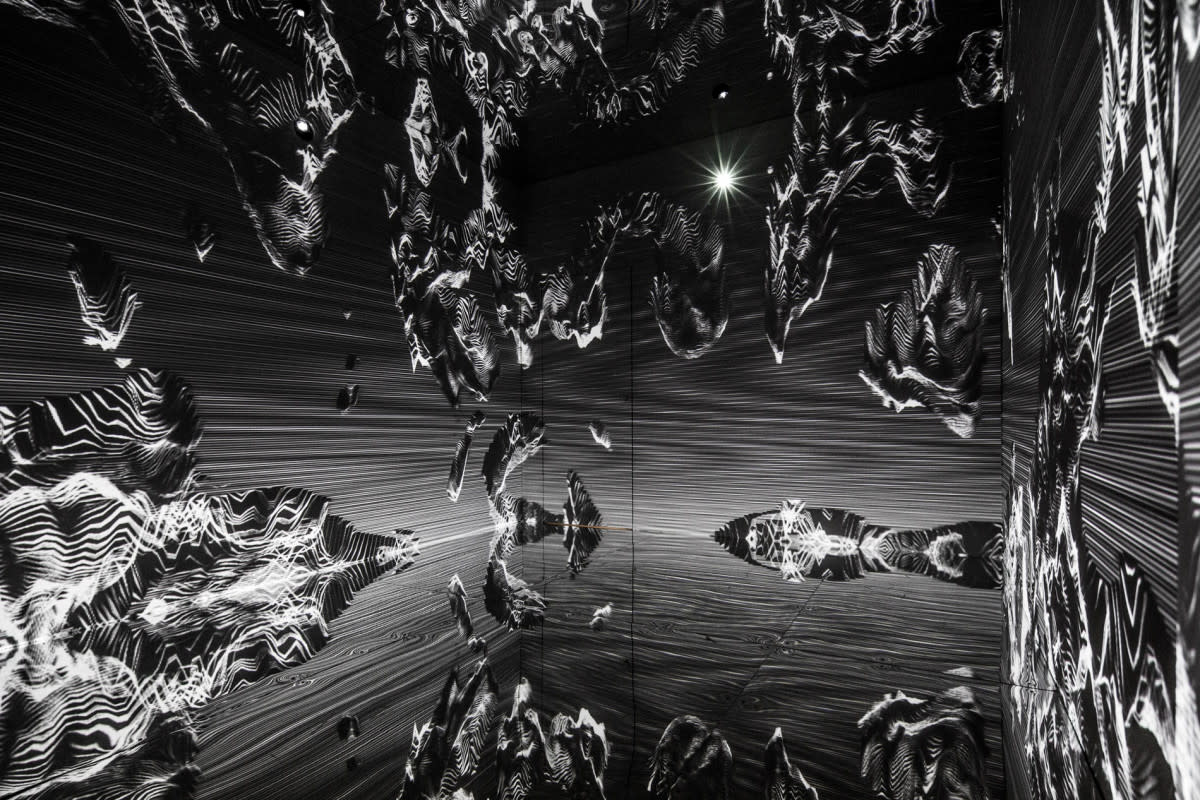Seeing the invisible: a conversation with Refik Anadol

It’s 10 a.m. in Auckland, 5 p.m. in Los Angeles. Refik Anadol has just stepped out of a meeting, blinking into the California sun, and out onto a terrace for a quick Skype call.
We’ve had a timing mix-up (iCal time-zone fails). While nominally I’m a day ahead, when Anadol starts describing his work I begin to think I’m living in the past; or, more likely, that he’s occupying a point in future. Maybe he’s been sent back in time to save the planet from machine overlords (that old trope)? No, he seems too nice. Anyone who signs off from an interview by saying, “I hope I haven’t been too dreamy”, has not come back in time to prevent humankind’s destruction.
Anadol is a self-described media artist and director – and a well-qualified one at that. He’s a double master – with a fine arts degree from the University of California and another from Bilgi University in his hometown, Istanbul. He’s also a lecturer and visiting researcher at UCLA’s Department of Design Media Arts, and a recipient of Google Arts and Culture’s Artists Machine Intelligence Artist Residency Award. He’s also been described him as a data painter and data sculptor; apt but not complete descriptions of what he does, which is immersive, site-specific public art, run through with themes of time and memory, and made physical through data harvesting, machine-learning and artificial intelligence. His work tends to challenge the viewer’s perception of architectural space and blur lines between physical and digital.
To put it simply: Anadol collaborates with machine intelligence in order to make the invisible visible; dipping a brush into “data universes” to create radical visualizations that explore “synergies between art and technology, and architecture and institutional memory”.
His best-known work is WDCH Dreams, a public art collaboration with Los Angeles Philharmonic that was projected onto the folded and undulating metal skin of the Walt Disney Concert in Los Angeles. It’s think really big stuff – eye-opening and ‘wow’-inducing, even on video. It would have been phenomenal to the boundary-pushing Frank Gehry building having its architectural boundaries tested further via machine intelligence (and 42 large-scale projectors with 50K visual resolution, 8-channel sound and 1.2M luminance).
To make the hall “dream”, Anadol used a computerised mind to mimic how humans dream, processing memories, harvesting 45 terabytes of data from the orchestra (587,763 image files, 1,880 video files, 1,483 metadata files, and 17,773 audio files) into millions of data points, with hundreds of attributes categorised by “deep neural networks with the capacity to both remember the totality of the LA Phil’s ‘memories’ and create new connections between them”.

Refik, how are you?
Very good, Michael, lovely to meet you.
Very good, Michael, lovely to meet you.
And you too, Refik. We’re looking forward to seeing you in Auckland in August. Have you been down this way before?
I’m very excited to be there and to share my works. My wife has been to Wellington – I was so jealous I couldn’t come, but she described the beautiful landscapes to me.
I’m very excited to be there and to share my works. My wife has been to Wellington – I was so jealous I couldn’t come, but she described the beautiful landscapes to me.
I’m interested in how you ended up doing what you do. What were you like when you were young? Did you have any early interests that led you to data art?
I think the biggest part of that story… I was about 8 years old when I watched the movie Blade Runner, the movie that changed my life. I didn’t even know English when I was watching it, in Istanbul, Turkey, where I was born. And my mother was constantly renting movies for me, to learn English, to learn culture. One day, I found this movie in a stack of movies and I was like, ‘wow’ – it was an incredible stage in my life. The same summer I also got my first computer. It was an incredible year in my life, computer, science fiction…
I think the biggest part of that story… I was about 8 years old when I watched the movie Blade Runner, the movie that changed my life. I didn’t even know English when I was watching it, in Istanbul, Turkey, where I was born. And my mother was constantly renting movies for me, to learn English, to learn culture. One day, I found this movie in a stack of movies and I was like, ‘wow’ – it was an incredible stage in my life. The same summer I also got my first computer. It was an incredible year in my life, computer, science fiction…
It all came together?
That’s really how I started thinking about the future and about space and science fiction as a tool of thinking, like a narrative, and then I think in high school I was pretty much clear about being a very creative mind. I wasn’t interested in being too analytic; I wasn’t interested in doing things with engineering or science, I was interested in the creative mindsets. As an undergrad, I was very lucky that at the university I was attending was super amazing. Our head of the department was a revolutionary creative mind who was pushing everyone. He was teaching us how to learn. He wasn’t teaching just random things – and so, if I can learn how to learn, I can apply it to everything simply.
That’s really how I started thinking about the future and about space and science fiction as a tool of thinking, like a narrative, and then I think in high school I was pretty much clear about being a very creative mind. I wasn’t interested in being too analytic; I wasn’t interested in doing things with engineering or science, I was interested in the creative mindsets. As an undergrad, I was very lucky that at the university I was attending was super amazing. Our head of the department was a revolutionary creative mind who was pushing everyone. He was teaching us how to learn. He wasn’t teaching just random things – and so, if I can learn how to learn, I can apply it to everything simply.
You’ve ‘painted’ the Walt Disney Concert Hall in L.A. with data, and several of your other projects have a relationship with architecture. Tell me a bit about this interest.
I was very fortunate that I was able to use light as a material on a building at the Zollverein Design School, where I was able to project onto the building and create a performance. That was nine, almost 10 years ago. There was a beautiful reaction from the audience and online communities; and similarly, for two or three years, I was in Europe, doing projects on the buildings. My passion was architecture – not drawing buildings but using data and light as a material and transforming and extending reality. Like turning reality into some kind of material, like turning time and space into a material. Those were my inward thoughts. My dream was to make only public art because I wasn’t that excited about museums and galleries to be honest, because I thought that museums and galleries are a biased experience – you have a door, you open it, but you are going to see art; I don’t think it’s like life. I think life is more public art, because it can be anytime, for anyone, for any reason, there’s no door, no entrance, and there’s no beginning, no end. I think it’s much more challenging for an artist, to be honest. I set myself a lot of personal challenges – I don’t like to make the same thing twice. I don’t like repeating myself...
I was very fortunate that I was able to use light as a material on a building at the Zollverein Design School, where I was able to project onto the building and create a performance. That was nine, almost 10 years ago. There was a beautiful reaction from the audience and online communities; and similarly, for two or three years, I was in Europe, doing projects on the buildings. My passion was architecture – not drawing buildings but using data and light as a material and transforming and extending reality. Like turning reality into some kind of material, like turning time and space into a material. Those were my inward thoughts. My dream was to make only public art because I wasn’t that excited about museums and galleries to be honest, because I thought that museums and galleries are a biased experience – you have a door, you open it, but you are going to see art; I don’t think it’s like life. I think life is more public art, because it can be anytime, for anyone, for any reason, there’s no door, no entrance, and there’s no beginning, no end. I think it’s much more challenging for an artist, to be honest. I set myself a lot of personal challenges – I don’t like to make the same thing twice. I don’t like repeating myself...

So, everything you do is another opportunity to learn something new or do something differently? You’ve got to keep changing?
Correct. I focused on public art and then I moved to the United States, and I was very lucky to work with many schools. In the end, I was fortunate to get into UCLA’s media art department, where I got my degree. I’ve been teaching there for the last five years. I’ve worked with many great mentors there, such as Casey Reas, Jennifer Steinkamp and Christian Moeller.
Correct. I focused on public art and then I moved to the United States, and I was very lucky to work with many schools. In the end, I was fortunate to get into UCLA’s media art department, where I got my degree. I’ve been teaching there for the last five years. I’ve worked with many great mentors there, such as Casey Reas, Jennifer Steinkamp and Christian Moeller.
Was that what you wanted to do after completing your degree? Stay in academia?
My dream was to open a studio. My first case study was using Frank Gehry’s Walt Disney Concert Hall and the Los Angeles Philharmonic. My dream was to turn the building into a building that has a capacity for learning and dreaming and remembering. In 2014, A.I. wasn’t really in the public realm, but in 2016 I was invited by Google Arts and Culture’s Artists and Machine Intelligence program as an artist in residence, so I was lucky to learn how to use A.I. with my team. That set me off again.
My dream was to open a studio. My first case study was using Frank Gehry’s Walt Disney Concert Hall and the Los Angeles Philharmonic. My dream was to turn the building into a building that has a capacity for learning and dreaming and remembering. In 2014, A.I. wasn’t really in the public realm, but in 2016 I was invited by Google Arts and Culture’s Artists and Machine Intelligence program as an artist in residence, so I was lucky to learn how to use A.I. with my team. That set me off again.
For our first project in the studio, we used live data, social metric activities, and many other things… data from the airport, like wind data, and building permits and lidar schemes. We had this vast amount of data that we played with and made art with it and sculpted data paintings. But after A.I. things changed much more quickly because A.I. means we have this machine consciousness, machine intelligence.
You recently talked about the role of becoming a creator of creator – you create the machine consciousness that creates the art – that’s an interesting concept to get your head around.
I think it’s really fun. You become a kind of superhuman! Also, as an artist you can dip your brush in the mind of a machine into and paint its machine consciousness, and that is very exciting. That means the consciousness becomes your medium, your substance, your material.
I think it’s really fun. You become a kind of superhuman! Also, as an artist you can dip your brush in the mind of a machine into and paint its machine consciousness, and that is very exciting. That means the consciousness becomes your medium, your substance, your material.
What is it about architecture then, that you find so interesting?
I think architecture is the most important field of creativity in humankind. You have beautiful buildings, but they are also limited, right? We have to worry about physics, we have to use glass, concrete and steel which is very boring, but for me I can use light as a material, which can change the capacity of any building. So Archive Dreaming (2017) is a project about transgressing the normal boundaries of a library and the conventional flat cinema-projection screen into a three-dimensional kinetic and architectonic space. It’s an archive visualized with machine learning algorithms. WDCH Dreams (2018) is a project about changing the structure of a concert hall; Melting Memories (2018) plays with the memory in substance, and things like that…it was the result of work with Neuroscape – a neuroscience center undertaking scientific research into brain function.
I think architecture is the most important field of creativity in humankind. You have beautiful buildings, but they are also limited, right? We have to worry about physics, we have to use glass, concrete and steel which is very boring, but for me I can use light as a material, which can change the capacity of any building. So Archive Dreaming (2017) is a project about transgressing the normal boundaries of a library and the conventional flat cinema-projection screen into a three-dimensional kinetic and architectonic space. It’s an archive visualized with machine learning algorithms. WDCH Dreams (2018) is a project about changing the structure of a concert hall; Melting Memories (2018) plays with the memory in substance, and things like that…it was the result of work with Neuroscape – a neuroscience center undertaking scientific research into brain function.
It seems like you’re living about 50 years in the future… you’ve become the Blade Runner…
Ha, the replicant. I’m a replicant!
Ha, the replicant. I’m a replicant!
We’ll have to test you as you come through the airport. The Walk Disney Concert Hall is not boring architecture, but you’ve been able to take that iconic building and do something remarkable with it.
It was a life-changing project. I was very much inspired by cinema, which is very important in my life. I believe that cinema as an art form is incredible, thinking that you can define a reality in your own mind and you just make it happen. It’s such a powerful medium, more so than any other medium, to be honest. I don’t know anyone in the world that does not like cinema.
It was a life-changing project. I was very much inspired by cinema, which is very important in my life. I believe that cinema as an art form is incredible, thinking that you can define a reality in your own mind and you just make it happen. It’s such a powerful medium, more so than any other medium, to be honest. I don’t know anyone in the world that does not like cinema.
WDCH Dreams was kind of like a cinematic experience in the future, but realized today, using today’s tools, plus Frank Gehry’s support, huge support, and the LA Phil’s incredible vision to support such a crazy idea to give us access to 100 years of information, their memories.

So, just to dip into mundane technical details – how did you harvest all the information and data?
I think that’s where I got much more inspired. In the last five years, I’m constantly practicing myself with my team to produce data as an artistic tool. We’ve had to learn how to use data in a way that is more exciting than just looking at the original folders. By using machine intelligence, you’re able to classify the image contributions, sound recognition, text recognition and create multiple data universes. Basically, by flying through those different universes, we try to make sure that we have enough material to create new forms of narrative, new forms of cinema.
I think that’s where I got much more inspired. In the last five years, I’m constantly practicing myself with my team to produce data as an artistic tool. We’ve had to learn how to use data in a way that is more exciting than just looking at the original folders. By using machine intelligence, you’re able to classify the image contributions, sound recognition, text recognition and create multiple data universes. Basically, by flying through those different universes, we try to make sure that we have enough material to create new forms of narrative, new forms of cinema.
Yes, the parallels with cinema are interesting, constructing a reality for the viewer in which to become absorbed and occupy. What are you working on now? I saw something about Mars on Instagram. What’s happening there?
Right now, we are thinking about space – our next home. We are doing a project in Washington D.C. and an exhibition called Mission Memoirs. It is focusing on the machines that are encoding the new reality for us, such as ISS, Hubble, Apollo mission, or MRO, which is the mars machine. We are collecting all the data sets from those machines and trying to narrate the machine memories as kind of a landscape and to look at those realities. I mean, the big question is, ‘What is the world’s most objective data?’ right? In space there’s no ego, there’s no privacy, you’ve just got to ask the universe. I feel like it’s less problematic data right now, in this madness. It feels fresh and honest to look at the universe.
Right now, we are thinking about space – our next home. We are doing a project in Washington D.C. and an exhibition called Mission Memoirs. It is focusing on the machines that are encoding the new reality for us, such as ISS, Hubble, Apollo mission, or MRO, which is the mars machine. We are collecting all the data sets from those machines and trying to narrate the machine memories as kind of a landscape and to look at those realities. I mean, the big question is, ‘What is the world’s most objective data?’ right? In space there’s no ego, there’s no privacy, you’ve just got to ask the universe. I feel like it’s less problematic data right now, in this madness. It feels fresh and honest to look at the universe.
Refik, you seem so optimistic about the possibilities of A.I. and machine learning, whereas others are more hesitant. Why is that?
Yeah, I’m very positive. There are similar relations between A.I. and previous inventions; I say this to everyone, but I think it’s like fire. We can cook with it or we can make weapons with it. A.I. is the same thing, right? We can cure cancer or we can make a horrible gun. It depends on who you are. I want to cure cancer. I want to fix the problems of humanity. I’m not interested in making a machine that can kill us all. I mean, machines can help us become more sensitive; machines can help us see problems much faster. It can be a problem solver. I’m on the optimistic side of the story.